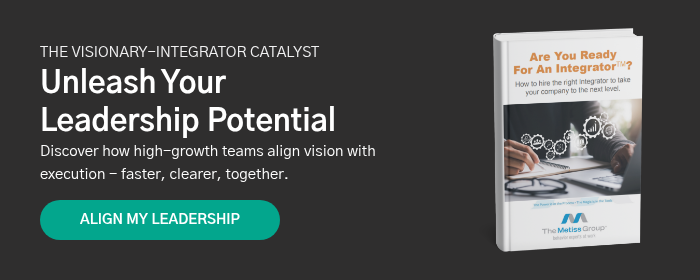When Should a Visionary Hand Everything Over to a New Integrator?
July 16th, 2025
4 min read
By Cyndi Gave

Handing over the reins sounds simple—until it isn’t.
Most Visionaries start with the best intentions: “Shadow me for a few weeks, soak it all in, and we’ll ease into the transition.” But without a clear date, a clear owner, and a clear plan, those good intentions stall out. The team keeps defaulting to the old way. The Integrator stays in limbo. And the leadership handoff that was supposed to create clarity ends up creating confusion instead.
We’ve seen this play out too many times—and we know how to fix it.
At The Metiss Group, we’ve helped leadership teams across diverse industries implement the EOS® model with precision. We know what works—and what backfires—when onboarding a new Integrator. One truth always holds: transitions succeed when expectations are explicit, timelines are fixed, and authority is established from day one.
In this article, you will learn:
- Why the EOS Integrator Transition Must Begin With a Fixed Date
- How to Define Ownership Timelines by Business Type
- The Importance of Role Clarity and The Job Scorecard
- Strategic Steps to Shorten the Integrator’s Learning Curve
Why the EOS Integrator Transition Must Begin With a Fixed Date
The single most critical component in transferring leadership to a new EOS Integrator is setting a firm transition date. This should be decided before onboarding begins. Whether the transfer is staged across three weeks or three months, ambiguity will compromise accountability. A precise timeline gives the new Integrator a clear target and informs the rest of the team who to look to for leadership.
When team members continue reporting to the previous leader because the Integrator “isn’t up to speed yet,” those habits become entrenched. This slows the Integrator’s development and prevents them from gaining a real-time understanding of team dynamics and business operations. Explicit authority from day one, paired with structured support, builds competence faster than informal shadowing.

How to Define Ownership Timelines by Business Type
The ideal handoff timeline varies depending on several business conditions:
Clarity in Role Expectations for the New Integrator
The first question to ask is: Does the Integrator know exactly what success looks like? If there’s no clear definition of the role, the new leader will struggle to know what to focus on and how they’ll be measured. A detailed Job Scorecard, one of the tools The Metiss Group helps organizations build, gives Integrators specific goals, behaviors, and outcomes to aim for. When the expectations are clear from the start, the timeline for taking over can be faster and more focused.
How the Current State of the Business Impacts Integrator Onboarding
Is your business in growth mode, facing a crisis, or running steadily? The state of your business can change how quickly the Integrator should take on full responsibility. In a turnaround or high-growth phase, it’s often best to get the Integrator involved right away with a project they can own. This speeds up learning and helps build trust with the team.

Why the Strength of the Leadership Team Matters in a Leadership Handoff
A strong leadership team can help the new Integrator ramp up more quickly. If your team is experienced, collaborative, and aligned with your company’s goals, they can guide the Integrator and make the transition smoother. But if some team members need to be upgraded, the Visionary may need to stay more involved at first.
How Business Complexity Affects the Speed of an Integrator Transition
Some businesses are more complex than others. If your company has technical products, highly regulated services, or complicated operations, it might take the Integrator longer to fully understand how things work. But that doesn’t mean they can’t lead early on. With the right support and access to subject matter experts, an Integrator can quickly get up to speed on the big picture.

The Role of Visionary Availability in Transitioning to a New Integrator
How much time does the Visionary have to support the transition? If they’re available and involved, it may be tempting to delay the handoff. But that can create confusion about who’s in charge. On the other hand, if the Visionary is already pulled into other projects or companies, then the Integrator needs to step up sooner. Either way, it’s important to define what the Integrator will own and when.
In high-pressure environments such as turnaround situations or rapid growth phases, onboarding can be accelerated. These circumstances provide natural projects for the Integrator to own from the outset. A clearly defined project under real business stress speeds integration and fosters camaraderie among the leadership team.
Conversely, in maintenance or plateaued environments, the challenge lies in manufacturing urgency. Assigning ownership of a strategic initiative—such as evaluating a new ERP system—gives the Integrator a valuable entry point. It prevents passive observation and instead encourages active engagement and organizational discovery.
The Importance of Role Clarity and the Job Scorecard
Role clarity remains foundational. A Job Scorecard that includes both success criteria and time-based milestones provides structure and direction. It shifts onboarding from a passive process to a strategic plan. With measurable benchmarks, the Integrator and Visionary can regularly review progress and recalibrate if necessary.
The Job Scorecard must not merely list responsibilities. It should include specific performance expectations and cultural alignment indicators. This clarity not only helps the Integrator prioritize learning but also aligns the broader team on what success looks like.
Strategic Steps to Shorten the Integrator's Learning Curve
Several key activities should be delegated to the Integrator immediately. These include running the Level 10 Meetings, leading EOS sessions, initiating one-on-ones with direct reports, and managing relationships with vendors, clients, and other external stakeholders. Taking over these responsibilities reinforces authority and provides the Integrator with a working understanding of organizational rhythms and expectations.
If the company uses an EOS Implementer, that relationship should transition to the Integrator early. This move supports continuity in EOS execution and deepens the Integrator’s grasp of strategic priorities.
Complex businesses with specialized offerings may present a longer runway. However, the Integrator’s goal is not technical mastery but strategic alignment. They must understand what the business delivers, why clients choose the organization, and what internal resources drive success. Subject matter experts can fill the technical gaps, while the Integrator focuses on synthesizing operations and supporting scalable growth.
Takeaways
Transferring leadership to a new EOS Integrator requires more than proximity and observation. It demands deliberate planning, defined timelines, and organizational discipline. Whether the context is high growth, operational stability, or business turnaround, the Integrator’s impact depends on the clarity of expectations and the speed of meaningful engagement. Leadership teams must resist the temptation of gradualism and instead commit to a structured, strategic onboarding process.
The Metiss Group helps organizations navigate leadership transitions with precision. By aligning hiring assessments, onboarding frameworks, and leadership development strategies, they enable new Integrators to step into their roles with clarity and confidence.
If you're a Visionary preparing to step back—or an Integrator stepping in—The Metiss Group’s Visionary Integrator Catalyst provides a guided framework to ensure a confident and cohesive transition. From defining ownership to strengthening communication rhythms, this program helps leadership pairs build trust and traction from day one.

